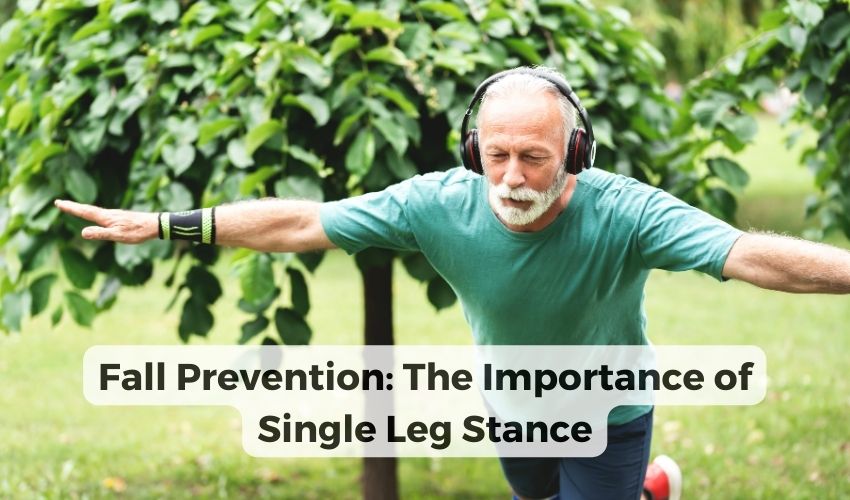As we age, maintaining balance and stability becomes increasingly vital for a fulfilling and independent life. In this blog post, we’ll explore the incredible benefits of practicing the single leg stance, an exercise designed to strengthen not only your muscles but also your confidence in everyday activities. Whether you’re a senior yourself or you’re caring for an older loved one, this guide will provide valuable insights into the world of balance training.
Why Single Leg Stance Matters for Seniors
For seniors, balance and stability are not just buzzwords but the pillars of a healthy lifestyle. Why, you might ask? First and foremost, they serve as the guardians against the ever-dreaded falls and injuries that can significantly impact our quality of life as we age. A strong foundation in balance can quite literally be a lifesaver.
One key element in the realm of balance is the single leg stance. This seemingly simple exercise plays a pivotal role in helping seniors regain and maintain their equilibrium. As we delve into this topic, you’ll discover how mastering the single leg stance can be the key to enhancing balance and stability for seniors.
Proper Form for Single Leg Stance
Balancing Act 101: The Right Posture
Before we leap into the world of single leg stances, it’s crucial to grasp the correct posture. Imagine standing tall, shoulders back, and head held high – that’s the essence of a proper single leg stance. Here’s a detailed breakdown of the steps:
- Stand with your feet hip-width apart.
- Shift your weight onto one leg while lifting the other slightly off the ground.
- Keep the lifted foot close to your standing ankle, either gently touching it or hovering just above.
- Engage your core muscles to maintain a neutral spine.
- Find a focal point, like a spot on the wall or the tip of your nose, to fix your gaze on. This will help you maintain balance.
To provide visual guidance, we’ve included a step-by-step guide with images to ensure you’re on the right track.
Benefits of Single Leg Stance
The single leg stance offers a plethora of benefits for seniors, both physical and mental. Let’s break them down:
Physical Benefits:
- Improved Balance: Enhancing your ability to stay steady on your feet and reducing the risk of falls.
- Strengthening Leg Muscles: Building lower body strength, which can aid in daily activities like walking and climbing stairs.
- Enhancing Core Stability: Fortifying your core muscles to improve posture and alleviate back pain.
Mental Benefits:
- Increased Concentration: The single leg stance requires focus, boosting your cognitive abilities.
- Enhanced Mindfulness: It connects your mind and body, promoting a sense of presence and mindfulness in your daily life.
Variations of Single Leg Stance
To accommodate seniors at different fitness levels, we’ve broken down the single leg stance into three categories: beginner, intermediate, and advanced. This approach ensures everyone can benefit from this exercise, no matter their starting point.
Beginner Variations:
- Start with toe taps or lightly touching a chair or wall for support.
Intermediate Variations:
- Gradually increase the duration of holding the single leg stance.
Advanced Variations:
- Challenge your balance by closing your eyes or adding controlled arm movements.
Discover the variation that suits you best, and progressively work your way up as you become more confident and stable.
Common Mistakes to Avoid
In the pursuit of balance, it’s common to encounter a few stumbling blocks. We’ve identified some of the most common mistakes seniors make while attempting the single leg stance, such as shifting hips to one side or raising the lifted leg too high. Don’t worry; we’ve got solutions and tips to help you correct these errors and ensure a safe and effective practice.
Precautions and Safety Measures
Safety is paramount when engaging in any exercise routine, especially for seniors. We’ll provide you with essential safety precautions, including using a sturdy chair or wall for support, practicing on a soft surface, and most importantly, consulting with a healthcare professional before embarking on this or any new exercise regimen.
Tips for Consistent Practice
Consistency is key when it comes to balance training. In this section, we offer practical tips to help seniors incorporate the single leg stance into their daily routines. By setting aside a specific time each day and tracking your progress, you’ll be on your way to better balance and stability.
Conclusion
In conclusion, we’ve explored the significance of balance and stability for seniors and unveiled the transformative potential of the single leg stance. With improved balance, strengthened muscles, and enhanced mindfulness, seniors can lead more vibrant, confident lives.
We encourage you to start incorporating the single leg stance into your daily routine. By doing so, you’ll be taking a significant step towards a healthier, happier you.
FAQs
The Single Leg Stance is a balance exercise that involves standing on one leg while maintaining stability. It’s a beneficial exercise for seniors to enhance their balance and reduce the risk of falls.
Balance is crucial for seniors because it helps prevent falls and related injuries. Improving balance can also enhance mobility and overall quality of life.
It’s recommended to practice balance exercises like the Single Leg Stance at least a few times a week. Start with a few seconds and gradually increase the duration as you become more comfortable.
Yes, ensure you have a sturdy support nearby, like a chair or wall, to grab onto if you lose balance. Perform the exercise on a non-slip surface, and consider doing it under supervision if you’re concerned about safety.

